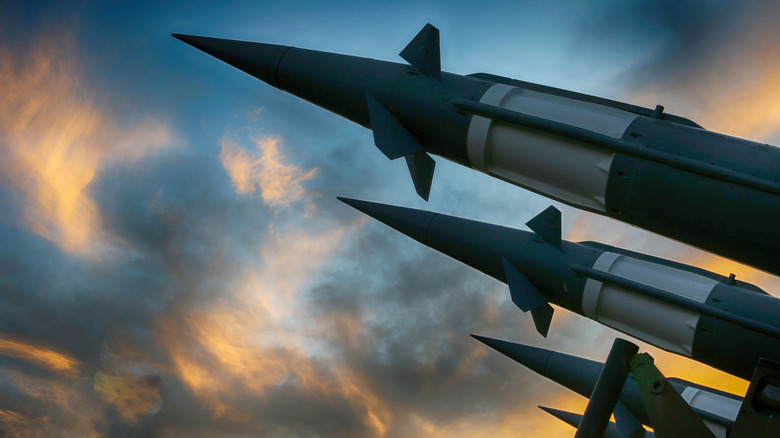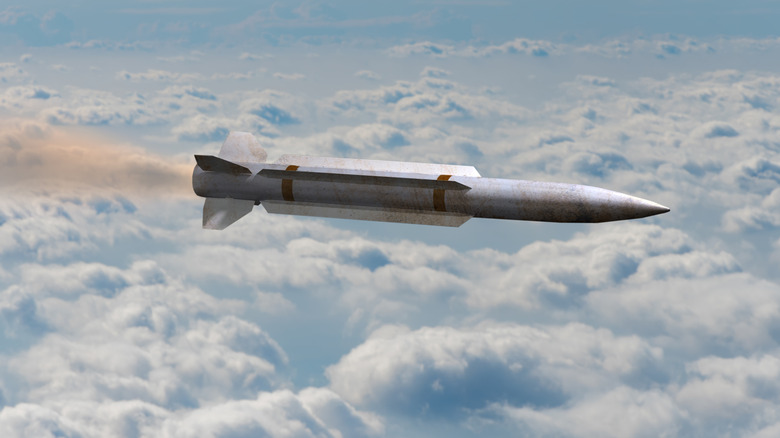What's The Difference Between Ballistic And Hypersonic Missiles?
Initially, ballistic and hypersonic missiles would appear to be interchangeable tools of modern warfare. After all, both can cover enormous distances and reach mind-bending speeds. But underneath their shared lethality, their operation and what exactly makes them dangerous fundamentally differ. Launched into space to descend back to Earth, traditional ballistic missiles (like intercontinental ballistic missiles, or ICBMs) rely primarily on gravity and momentum after the initial burn. As such, they follow a parabolic arc. Conversely, hypersonic missiles are designed to fly inside the atmosphere at speeds above Mach 5 while maneuvering en route to their targets.
This important difference affects not only theoretical but practical aspects of both deploying and countering these weapons. Fast but predictable, ballistic missiles have been around since the Cold War and are more vulnerable to modern missile defense systems even if they can carry nuclear payloads across continents. More recently developed are hypersonic missiles, particularly cruise missiles and glide vehicles (HGVs). Their erratic, low-altitude maneuverability makes them far more difficult to find and stop.
The line separating strategic advantage from global instability is diminishing as nations rush to create these next-generation hypersonic weapons. To appreciate how warfare is changing in the 21st century, one must first understand the technological and tactical variations among these missile types.
Ballistic missiles offer speed and predictability
Range is a key factor in differentiating various types of ballistic missiles. These include: short-range (SRBM), medium (MRBM), intermediate (IRBM), and intercontinental (ICBM) missiles. These incredibly powerful missiles, once fired, have a high-arching trajectory akin to that of a thrown rock. During the boost phase, the missile burns fuel, after which it coasts through space before rapidly reentering the atmosphere. Ballistic missiles can travel impressively long distances, with ICBMs being able to reach up to 5,500 miles away.
Ballistic missiles do have a few drawbacks even if the speeds they can reach are amazing. They're costly and complicated to build, for one, and their arc can be computed with substantial accuracy once they're in flight; allowing missile defense systems to track and intercept them relatively easily. That said, efforts at interception have been complicated by developments in several independently targetable reentry vehicles (MIRVs) — warheads which split into several bombs mid-flight. Although ballistic missiles are still crucial for nuclear deterrence plans, particularly in nuclear-armed nations, their dependence on decades-old technologies and predictability make them prime targets for interference by more modern systems.
Hypersonic missiles offer maneuverability at speed
Hypersonic missiles, unlike ballistic missiles, don't have to leave the atmosphere to reach their targets. These weapons, capable of reaching speeds up to Mach 5, can make quick course corrections during flight. Examples include hypersonic glide vehicles and hypersonic cruise missiles. With current missile defense systems being what they are, the reason these missiles are almost impossible to intercept is due to their incredible maneuverability.
Hypersonic weapons blur the line between conventional and nuclear warfare (as the Center for Arms Control and Non-Proliferation notes) since they can be used for both purposes and provide little warning time. In what marks a new arms race, nations like China, Russia, and the United States are actively building hypersonic platforms. These weapons make surprise attacks more practical which undermines current deterrent systems.
However, this doesn't mean hypersonics are free of shortcomings. The immense heat produced at such high speeds can affect electronics and material integrity. For now, the high cost of development and deployment currently limit how frequently they're actually used. That said, given the countless billions countries spend on hypersonic research and testing, it's only a matter of time before these weapons proliferate; drastically changing world military strategy in the process.


